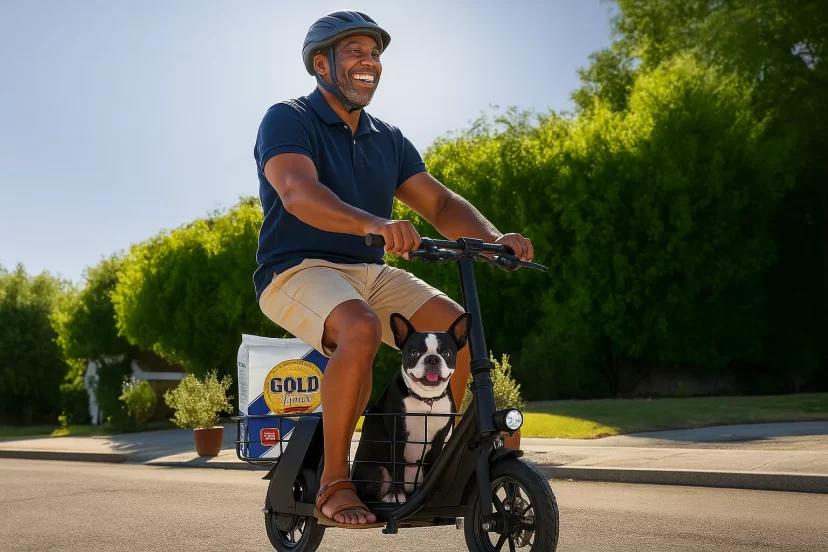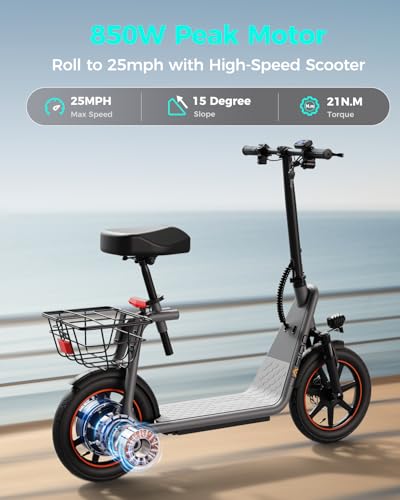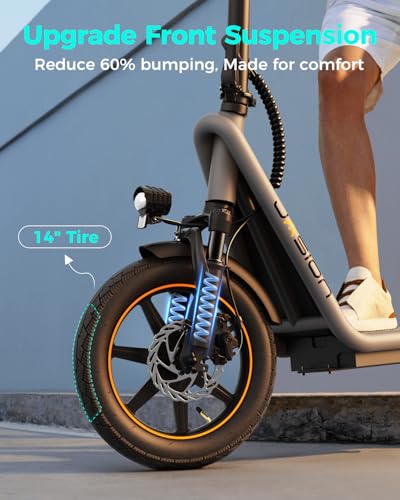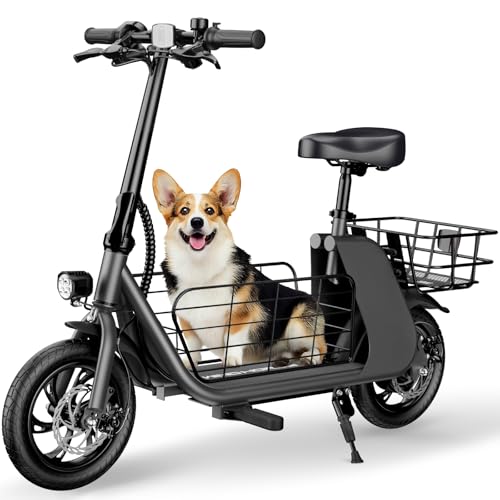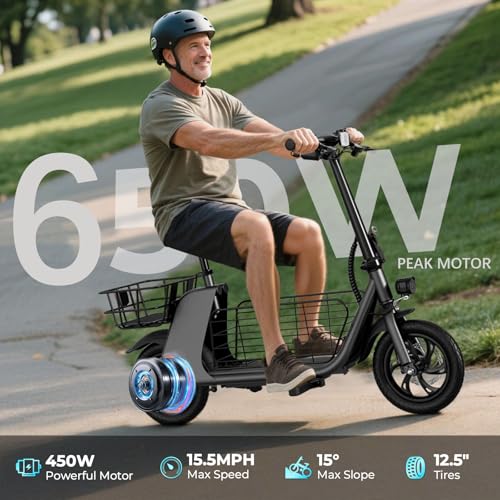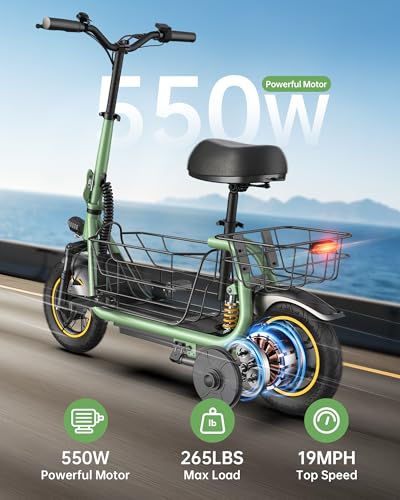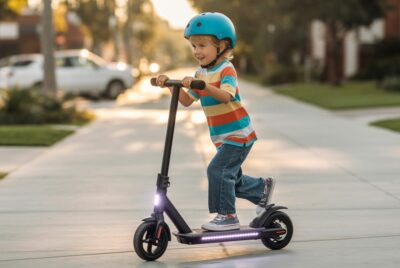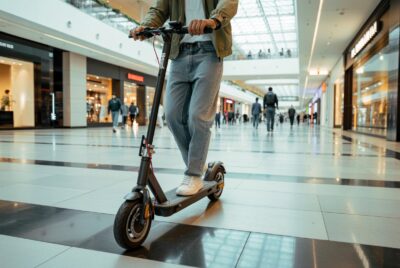Pet-Friendly Electric Scooters
*We may earn a commission for purchases made using our links. Please see our disclosure to learn more.
Pet owners know the struggle all too well—leaving behind those pleading eyes when heading out for a ride around the neighborhood or running quick errands. The guilt of choosing between adventure and companionship doesn’t have to exist anymore. The emergence of pet-friendly electric scooters has transformed how people travel with their furry friends, creating opportunities for shared experiences that strengthen bonds while embracing sustainable transportation.
These innovative mobility solutions bridge the gap between traditional pet transportation and modern commuting needs. Whether navigating city streets, exploring park trails, or simply running errands, having a four-legged companion along for the journey adds joy to everyday routines while solving practical challenges faced by pet parents everywhere.
“The integration of pets into personal transportation devices reflects our evolving understanding of animal companionship—they’re not just pets we care for, but partners we adventure with through life’s daily journeys.”
— Urban Mobility Research Journal
Key Takeaways
- Dual-Purpose Design: Pet-friendly electric scooters feature integrated baskets, seats, or storage compartments specifically designed to safely transport small to medium-sized pets while maintaining rider stability and control.
- Safety Features: Look for models with secure enclosures, wide decks, shock-absorbing tires, and reliable braking systems to ensure both rider and pet safety during travel.
- Weight Capacity: Most pet-friendly scooters support 245-330 lbs total load, accommodating the rider, pet, and cargo, making them versatile for multiple uses beyond pet transportation.
- Range and Performance: Quality models typically offer 15-25 mile ranges with speeds up to 20 mph, powered by 550-850W motors that handle inclines and varied terrain.
- Comfort Considerations: Adjustable seats, shock-absorbing suspension systems, and spacious storage areas make longer rides comfortable for both human and animal passengers.
Recommended Pet-Friendly Electric Scooters on Amazon
Gyroor Adults Electric Scooter with Large Middle Basket
The Gyroor Adults Electric Scooter with Large Middle Basket is a standout choice for anyone looking for truly pet-friendly electric scooters. Powered by a strong 550W motor and offering speeds up to 18.6 MPH with a 20-mile range, this scooter delivers smooth, dependable rides. Its spacious middle basket easily fits small pets or cargo, while the sturdy 12" shock-absorbing tires ensure comfort and stability for both rider and furry companion. With dual disc brakes, bright lights, and a foldable, durable frame that supports up to 265 lbs, it’s built for safety and convenience. The adjustable seat and clear LCD display make every trip comfortable, practical, and pet-ready.
If you’re searching for reliable pet-friendly electric scooters, the Gyroor Adults Electric Scooter with Large Middle Basket is one of the best options available. Designed with both riders and pets in mind, this model features a comfortable adjustable seat and a wide, stable deck that makes traveling with small pets easy and safe. The spacious detachable basket securely carries your furry friend or daily essentials without compromising ride quality.
- Performance: Strong 550W motor with up to 20 miles of travel per charge.
- Pet-Friendly Design: Large middle basket and wide deck perfect for carrying small pets.
- Comfort & Safety: Smooth 12" tires, dual disc brakes, and bright headlight for secure rides.
- Weight: Heavier than basic scooters due to the metal frame and baskets.
- Speed Limit: Max speed of 18.6 MPH may feel modest for experienced riders.
- Bulkier Setup: Seat and baskets make it less compact when folded.
Jasion JS3 PRO Electric Scooter with Seat
The Jasion JS3 PRO Electric Scooter with Seat is an excellent choice for riders searching for powerful and reliable pet-friendly electric scooters. Equipped with a peak 850W rear-wheel motor, this scooter reaches up to 25 MPH and delivers a smooth, stable ride with its large 14-inch pneumatic tires and upgraded front suspension. The durable rear basket supports up to 45 lbs, ideal for groceries, cargo, or securely carrying small pets. Its long-lasting 36V 10AH battery offers up to 25 miles per charge, while safety features like dual disc brakes, bright headlights, turn signals, and anti-lock braking ensure confident riding day or night. With a foldable frame, ergonomic seat, and lockable design, the JS3 PRO blends performance, convenience, and pet-ready functionality.
The Jasion JS3 PRO Electric Scooter with Seat stands out as one of the most versatile pet-friendly electric scooters on the market, offering a strong mix of power, comfort, and utility. Designed with a high-torque 850W peak motor, it reaches impressive speeds of 25 MPH, making it well-suited for daily commuting, recreational rides, or weekend outings with your furry companion. Its large 14-inch pneumatic tires and upgraded front suspension absorb bumps and uneven surfaces, ensuring a smooth, stable experience for both rider and pet.
- Power & Range: Strong 650–850W peak motor with up to 25 miles per charge.
- Pet-Friendly Setup: Wide non-slip deck and a sturdy 45-lb rear basket perfect for pets.
- Comfort & Safety: Front suspension, dual disc brakes, and bright lighting for safer rides.
- Charging Time: 5–6 hour full charge may feel long for frequent riders.
- Bulkier Build: Larger tires and seat make it less compact than minimalist scooters.
- Keyed Start: Added security but may be inconvenient if keys are misplaced.
Windhorse R1 Pro Electric Scooter
The Windhorse R1 Pro Electric Scooter with Seat is a top choice for riders seeking reliable and thoughtfully designed pet-friendly electric scooters. Featuring a unique dual-basket system, this scooter includes a ventilated middle basket made for transporting small pets up to 30 lbs, plus a rear basket for groceries or cargo. Powered by a 450W motor with speeds up to 15.5 MPH, the R1 Pro offers a smooth 20-mile range perfect for commuting, park trips, or errands. Its sturdy frame supports up to 265 lbs, while the wide cushioned seat, 12.5" air-filled tires, and dual disc brakes ensure comfort and safety for both rider and pet. Foldable, practical, and built for daily use, it’s a dependable solution for pet lovers on the go.
The Windhorse R1 Pro Electric Scooter is redefining what pet-friendly electric scooters can offer, thanks to its innovative and practical dual-basket system. Designed for adults, teens, and commuters, this model features a ventilated middle basket specifically created for transporting small pets comfortably and safely. Pets up to 30 lbs can sit securely with proper airflow, making it a great mobility option for daily pet trips, vet visits, or park outings. The additional rear basket adds functional storage for groceries, backpacks, or everyday essentials, enhancing the scooter’s versatility.
- Pet-Focused Design: Dual baskets include a ventilated middle basket ideal for small pets.
- Comfortable Riding: Extra-wide cushioned seat and 12.5" air-filled tires provide smooth rides.
- Safe & Practical: Dual disc brakes and LED headlight improve visibility and control.
- Moderate Speed: 15.5 MPH max may feel slow compared to higher-end scooters.
- Battery Capacity: 36V 8Ah battery offers good range but slower acceleration than larger packs.
- Basket Weight Limits: Pet basket maxes at 30 lbs, limiting larger pets.
Urbanmax Upgraded C1Pro Electric Scooter with Seat
The Urbanmax Upgraded C1Pro Electric Scooter with Seat is a strong contender for anyone searching for comfortable and reliable pet-friendly electric scooters. Powered by a 550W motor and a 36V 10.4Ah battery, it reaches 19 MPH and delivers up to 25 miles per charge—perfect for commuting or leisurely rides with your pet. The scooter includes a large removable front basket and an additional rear basket, offering flexible storage for small pets, groceries, and daily essentials. With 12-inch pneumatic tires, dual shock absorbers, and a dual braking system, the C1Pro provides a stable, smooth ride on various terrains. UL2272 certification ensures high safety standards, while adjustable handlebars and seat height offer a personalized and comfortable riding experience.
The Urbanmax C1Pro Electric Scooter stands out in today’s growing market of pet-friendly electric scooters, offering a balanced mix of performance, comfort, and practical storage options. Engineered with a 550W motor, it provides smooth acceleration and a top speed of 19 MPH, while the high-capacity 36V 10.4Ah battery delivers an impressive 25-mile range on a single charge. This makes it a dependable choice for commuters, casual riders, and pet owners looking for a comfortable way to travel with their furry companions.
- Strong Performance: 550W motor with 25-mile range and 3 speed modes.
- Pet-Ready Baskets: Removable front basket and rear basket make it ideal for carrying small pets.
- Smooth, Safe Ride: Dual shocks, 12" tires, and dual braking improve comfort and security.
- Speed Cap: 19 MPH max may feel limiting to riders seeking faster scooters.
- Bulkier Build: Dual baskets and seat make it less compact when folded.
- Heavier Weight: Sturdy aluminum frame can be harder to carry on stairs or transit.
Understanding Pet-Friendly Electric Scooters
The concept of transporting pets via personal mobility devices isn’t entirely new, but the integration of purpose-built features into electric scooters represents a significant evolution in design thinking. Unlike makeshift solutions involving aftermarket baskets or carriers, modern pet-friendly electric scooters incorporate safety, comfort, and functionality from the ground up.
These specialized scooters typically feature secure storage compartments or designated spaces where small dogs can ride safely, with designs that prioritize both the pet’s comfort and the rider’s stability. The engineering behind these vehicles considers weight distribution, visibility, and accessibility—factors that directly impact the riding experience for both human and animal.
Pet-friendly electric scooters serve multiple demographics beyond obvious pet owners. Elderly individuals with mobility challenges find them useful for maintaining independence while keeping companion animals close. Urban commuters appreciate the multi-functional design that transforms shopping trips into pet-friendly adventures. Even delivery workers and service providers benefit from the cargo capacity that doubles as pet transportation when needed.
The Evolution of Pet Transportation Solutions
Traditional pet transportation methods have long presented challenges. Bicycle baskets offer minimal security and expose pets to weather elements. Car travel requires dedicated trips, contributing to carbon emissions and traffic congestion. Pet strollers lack the speed and efficiency needed for practical errands. Walking remains time-consuming, especially for older or mobility-limited pets who tire easily.
Innovations like the Mopet, designed by Japan-based companies, pioneered the concept of electric scooters with built-in cage-like carriers measuring approximately 45 x 33 x 21 cm, suitable for small dog breeds including pugs, chihuahuas, pomeranians, french bulldogs, beagles, and poodles. These early models established design principles that continue influencing contemporary products.
The shift toward pet-friendly electric scooters reflects broader societal trends. Pet ownership has surged dramatically, with animals increasingly viewed as family members deserving inclusion in daily activities. Simultaneously, environmental consciousness drives demand for alternative transportation reducing carbon footprints. Electric scooters naturally align with both trends, offering sustainable mobility that accommodates beloved companions.
Design Features That Matter
Safety First: Enclosed Spaces and Secure Attachment
The paramount concern when transporting pets involves security. Well-designed pet-friendly scooters incorporate enclosed compartments with locked doors or secure lids preventing accidental escape. Mesh panels or openings allow pets to observe surroundings while maintaining containment. Some models feature adjustable tethering points for harness attachment, providing backup security layers.
Stability mechanisms ensure the scooter remains balanced despite shifting weight from curious or excited pets. Wide decks, often measuring 9.5 inches or more, provide ample space that accommodates both rider positioning and pet placement, while low centers of gravity prevent tipping during turns or stops.
Comfort Elements for Extended Rides
Pet comfort directly influences the success of scooter transportation. Padded basket interiors cushion against vibration and bumps. Adequate ventilation through mesh windows or strategically placed openings ensures proper airflow, preventing overheating during warm weather. Size-appropriate compartments allow pets to sit, stand, or lie comfortably according to preference.
Rider comfort equally deserves attention. Adjustable seats accommodate various rider heights, with ranges typically spanning from 4’9″ to 6’1″, while breathable seat materials prevent discomfort during extended journeys. Shock-absorbing suspension systems and pneumatic tires smooth out road imperfections, creating pleasant experiences for all passengers.
Storage Versatility Beyond Pet Transport
One hallmark of quality pet-friendly scooters involves multi-purpose functionality. Removable baskets transform pet carriers into cargo holders for groceries, work supplies, or recreational equipment. Dual-basket configurations separate pet space from storage needs, enabling simultaneous transportation of animals and belongings.
Large detachable baskets can accommodate up to 45 pounds of cargo, making these scooters genuinely practical for daily errands. Rear utility trays, front baskets, and middle compartments create customizable storage solutions adapting to changing needs throughout the day.
Performance Specifications That Support Pet Travel
Motor Power and Speed Capabilities
Pet transportation requires sufficient power to handle combined weight loads without sacrificing performance. Most pet-friendly scooters feature motors ranging from 550W to 850W peak output, delivering speeds between 18-25 mph. This performance level accommodates urban traffic flow while maintaining safety margins for precious cargo.
Hill-climbing ability becomes crucial in varied terrain. Quality motors handle inclines up to 15 degrees, ensuring trips don’t become limited by geography. Acceleration smoothness prevents jarring starts that might frighten anxious pets, while responsive throttle control allows gentle speed adjustments.
Battery Life and Range Considerations
Range anxiety affects pet owners differently than typical commuters. Running out of power mid-journey with a pet aboard creates stressful situations. Reliable models offer 20-25 mile ranges on single charges, providing comfortable buffers for round-trip excursions plus unexpected detours.
Battery capacities allowing up to 60km travel distance on single charges represent premium options for extended adventures. Fast charging capabilities, typically completing in 5-6 hours, minimize downtime between uses. LCD displays showing real-time battery levels help riders plan routes appropriately, avoiding unpleasant surprises.
Weight Capacity and Load Distribution
Total weight capacity determines practicality for pet transportation. Most models support 245-330 lbs maximum loads, accommodating average adult riders plus pets and cargo. However, effective weight distribution matters as much as total capacity. Center-mounted pet compartments maintain balance better than front or rear configurations, particularly when carrying heavier pets.
Weight calculations should account for full scenarios: rider weight, pet weight, cargo weight, plus safety margins. A 200-lb rider with a 20-lb dog and 10 lbs of supplies needs a scooter rated for at least 265 lbs, preferably higher for longevity and performance consistency.
Choosing the Right Scooter for Your Pet
Assessing Pet Size and Temperament
Not all pets suit scooter transportation. Small to medium dogs under 30 pounds typically fit comfortably in standard baskets. Larger breeds may require custom solutions or alternative transportation methods. Beyond physical dimensions, temperament matters enormously. Calm, easily trained pets adapt quickly to scooter rides. Anxious, hyperactive, or aggressive animals might struggle with confined spaces and moving environments.
Senior dogs or those with mobility issues often appreciate scooter rides, finding them less taxing than extended walks. Puppies and young dogs can learn to enjoy scooter travel through gradual introduction and positive reinforcement. Always consider individual personality traits when determining suitability.
Evaluating Basket Configurations
Different basket styles serve different needs. Center-deck baskets provide low centers of gravity and excellent stability but reduce foot space. Rear baskets maintain full deck access but shift weight backward, affecting handling. Front baskets offer easy pet monitoring but can obstruct forward visibility and make steering heavier.
Basket dimensions must accommodate pets comfortably with room for slight movement. Overly tight spaces cause distress; excessively large compartments allow dangerous jostling. Typical pet compartments measure approximately 45 x 33 x 21 cm, suitable for most small breeds while maintaining structural integrity.
Climate and Weather Considerations
Weather resistance protects both equipment and passengers. Water-resistant ratings (IPX4 or higher) safeguard electrical components during light rain, though heavy downpours should be avoided. Basket covers shield pets from wind and precipitation, while mesh windows maintain airflow during warmer conditions.
Extreme temperatures require special attention. Hot weather demands excellent ventilation preventing overheating. Cold conditions may necessitate blankets or pet clothing for warmth. Asphalt surface temperatures deserve consideration—scorching pavement in summer can burn paw pads even when pets ride in baskets if stops require ground contact.
Safety Protocols and Best Practices
Pre-Ride Preparation and Training
Successful pet scooter transportation begins long before hitting the road. Gradual acclimation helps pets adjust to new experiences. Start by allowing pets to explore the stationary scooter, associating it with positive experiences through treats and praise. Progress to brief, slow rides in quiet areas, gradually increasing duration and complexity as confidence builds.
Safety equipment includes properly fitted harnesses (never collars which can cause choking) with secure tethering to basket attachment points. Leashes should allow comfortable positioning without excessive slack creating tangling hazards. Some owners use pet-specific safety vests with reflective materials improving visibility.
Riding Technique Adjustments
Transporting pets requires modified riding approaches. Smoother acceleration and deceleration prevent basket jostling that might frighten or injure animals. Wider turning radii avoid sharp angles causing excessive centrifugal force. Reduced maximum speeds prioritize stability over quick travel times.
Constant awareness of pet behavior helps identify distress signals. Unusual vocalizations, excessive movement, or attempts to escape indicate problems requiring immediate attention. Regular rest stops allow bathroom breaks, water consumption, and stress relief during longer journeys.
Legal and Community Considerations
Regulations governing electric scooter use vary significantly by location, with pet transportation adding complexity. Some jurisdictions classify pet-carrying scooters as bicycles, others as motor vehicles requiring specific licensing or restrictions. Sidewalk versus road usage rules often differ from standard scooters when transporting animals.
Insurance considerations warrant attention. Standard homeowner’s or renter’s policies may not cover accidents involving electric scooters. Specialized liability coverage protects against potential claims from injuries or property damage occurring during pet-transporting rides.
Community etiquette matters for maintaining positive relationships with neighbors and fellow path users. Controlling pet noise, preventing aggressive behavior toward pedestrians or other animals, and respecting “no pets allowed” zones demonstrate responsible ownership encouraging broader acceptance of this transportation method.
Maintenance for Longevity and Safety
Regular Inspection Routines
Pet-friendly scooters require diligent maintenance ensuring safe operation. Weekly pre-ride checks should examine tire pressure and condition, brake responsiveness, lighting functionality, and battery charge levels. Monthly deeper inspections cover electrical connections, frame integrity, suspension components, and basket attachment security.
Pet-related maintenance includes basket cleaning removing hair, dirt, and odors that accumulate through use. Disinfecting surfaces prevents bacterial growth in areas contacted by animals. Checking for chew damage on accessible components prevents electrical hazards or structural failures.
Battery Care and Charging Practices
Battery longevity directly impacts long-term value. Proper charging habits include avoiding complete depletion, storing scooters at partial charge during extended non-use periods, and protecting batteries from temperature extremes. Following manufacturer guidelines for charging duration and frequency maximizes lifespan and performance.
Environmental factors affect battery performance. Cold weather reduces capacity temporarily; hot conditions accelerate degradation permanently. Storing scooters indoors during severe weather protects battery systems and electronic components from damage.
Tire and Brake Maintenance
Tire condition critically impacts safety and ride quality. Pneumatic tires require regular pressure checks—underinflated tires compromise handling and increase puncture risk; overinflation creates harsh rides and potential blowouts. Tread wear monitoring prevents reduced traction in wet conditions. Solid tires need inspection for cracking or deformation indicating replacement needs.
Brake systems demand particular attention when transporting pets. Increased weight loads require stronger stopping power. Regular brake pad inspection identifies wear before failure, while cable adjustments maintain proper tension. Test braking effectiveness in safe areas before each ride carrying animals.
Real-World Applications and Use Cases
Daily Commuting with Canine Companions
Urban professionals increasingly incorporate pet transport into commuting routines. Morning coffee runs become shared experiences rather than rushed solo trips. Lunch breaks extend outdoor time for office workers and their dogs, improving mental health for both. Afternoon errands accommodate pet pickups from daycare or grooming appointments without requiring separate car trips.
Commuting benefits extend beyond convenience. Reduced vehicle usage lowers carbon footprints while decreasing parking challenges. Exercise opportunities increase as scooter trips replace sedentary car drives. Social connections develop among fellow pet-owning riders, creating community bonds through shared interests.
Recreational Adventures and Exercise
Beyond utilitarian transportation, pet-friendly scooters enable recreational exploration. Park trails become accessible regardless of pet stamina levels. Beach visits don’t require carrying tired dogs back to vehicles after swimming. Outdoor festivals and events become feasible destinations with pets having secure, comfortable transportation rather than being left home.
Elderly or injured pets particularly benefit from recreational scooter use. Animals with arthritis, hip dysplasia, or recovering from surgery can participate in outings they’d otherwise miss. This inclusion significantly improves quality of life while maintaining human-animal bonding through shared experiences.
Accessibility Solutions for Mobility Challenges
Pet-friendly electric scooters serve as mobility aids for individuals with physical limitations. People using canes, walkers, or wheelchairs often struggle walking dogs traditionally. Seated scooters with pet compartments restore independence, enabling continued pet ownership that might otherwise become impossible.
Service animal handlers find these scooters valuable for non-working hours, allowing service dogs rest periods while maintaining mobility. Therapy animal transporters utilize them for efficient movement between client locations. Veterinary professionals employ them for transporting patients requiring special handling during transport.
Overcoming Common Challenges
Addressing Pet Anxiety and Resistance
Some pets initially resist scooter transportation. Patience and gradual desensitization prove most effective. Creating positive associations through favorite treats exclusive to scooter rides helps. Covering baskets with familiar-smelling blankets provides comfort through recognizable scents. Playing calming music or maintaining gentle conversation reassures nervous animals.
Persistent anxiety might require professional intervention. Veterinary behaviorists can recommend anxiety-reducing strategies or medications for particularly stressed pets. Some animals never adjust to scooter travel—recognizing and respecting these limits prevents forcing unsuitable situations.
Managing Weather and Seasonal Limitations
Seasonal weather variations challenge year-round pet scooter use. Summer heat necessitates early morning or evening rides avoiding midday temperatures. Winter cold requires shorter durations preventing hypothermia or frostbite. Rain creates slippery surfaces and wet, uncomfortable conditions for pets despite covered baskets.
Creative solutions extend usable seasons. Cooling vests and frozen water bottles combat heat. Insulated basket liners and pet jackets address cold. Waterproof basket covers with adequate ventilation protect from rain. However, recognizing genuine limitations and choosing alternative transportation during extreme weather demonstrates responsible pet care.
Dealing with Public Reactions and Interactions
Pet-friendly scooter riders attract attention—positive and negative. Curious onlookers want to meet adorable scooter-riding dogs. Children approach without warning, potentially startling nervous pets. Some people express disapproval regarding animal transportation methods they don’t understand.
Handling public interactions gracefully maintains positive community relations. Politely answering questions educates others about pet-friendly scooters. Setting boundaries protecting pet space prevents unwanted touching. Sharing experiences online connects with supportive communities while potentially influencing broader acceptance.
Environmental and Economic Impacts
Sustainable Transportation Benefits
Electric scooters represent environmentally superior alternatives to car-based pet transportation. Zero direct emissions during operation reduce air pollution in urban areas. Lower energy consumption compared to vehicles—even electric cars—decreases overall carbon footprints. Reduced traffic congestion benefits entire communities beyond individual riders.
Manufacturing impacts deserve consideration. Battery production carries environmental costs, though properly recycled batteries minimize waste. Quality scooters lasting years offset initial production impacts through extended useful lives. Choosing durable, repairable models over disposable alternatives supports sustainability principles.
Cost Comparison with Alternatives
Financial analysis reveals pet-friendly scooter advantages over traditional options. Initial purchase costs ($400-$800 for quality models) compare favorably to years of gas, insurance, and maintenance for vehicles used primarily for pet transportation. Monthly operating costs remain minimal—electricity charges for charging and occasional maintenance supplies.
Car trip elimination generates substantial savings. A pet owner making five weekly short car trips for pet-related errands (1.5 miles average distance) at $0.50/mile vehicle operating cost spends approximately $195 annually just on those trips, not counting parking fees or time costs. An electric scooter typically costs under $50 annually in electricity for comparable usage.
Long-Term Value Considerations
Quality pet-friendly electric scooters provide years of reliable service when properly maintained. Warranties typically cover 6-12 months, with batteries often receiving separate coverage. Replacement battery costs ($100-$200) eventually arise but occur infrequently with proper care—usually every 2-3 years under regular use.
Resale value remains decent for well-maintained scooters. The growing popularity of electric mobility devices sustains secondary markets where upgraders can recoup portions of original investments. Alternatively, long-term ownership amortizes initial costs across thousands of rides, driving per-use costs to minimal levels.
Future Trends and Innovations
Technological Advancements on the Horizon
Electric scooter technology continues rapid evolution, with pet-friendly features keeping pace. Smart climate control systems may soon regulate pet compartment temperatures automatically. GPS tracking integrated with pet monitoring apps could provide real-time location sharing and pet vital sign monitoring. Advanced suspension systems promise smoother rides over rough terrain.
Battery technology improvements will extend ranges while reducing charging times and costs. Lighter, more powerful motors will improve performance without sacrificing portability. Modular designs might enable customizable configurations adapting to different pets or cargo needs throughout scooter lifespans.
Expanding Market and Product Diversity
Growing demand for pet-friendly transportation drives product development. Specialized models catering to specific breeds or activities will proliferate. Adventure-oriented scooters with rugged tires and waterproof components will serve outdoor enthusiasts. Luxury models offering premium comfort features will appeal to high-end markets.
Integration with broader smart city infrastructure seems likely. Dedicated parking areas for pet-carrying scooters could emerge in pet-friendly districts. Charging stations at popular dog parks would remove range anxiety for longer visits. Specialized bike lanes accommodating scooters with animal passengers might develop in progressive municipalities.
Community Building and Social Connection
Pet-friendly scooter ownership fosters unique communities. Online forums and social media groups connect enthusiasts sharing tips, organizing group rides, and advocating for pet-friendly policies. Local meetups create opportunities for pets to socialize while owners exchange experiences and recommendations.
These communities drive innovation through user feedback influencing manufacturer designs. Crowdsourced knowledge bases help new riders avoid common mistakes. Collective advocacy efforts push for legal reforms and infrastructure improvements benefiting all members. The social dimension often becomes as valuable as the transportation utility itself.
Conclusion
Pet-friendly electric scooters represent more than novel transportation gadgets—they embody evolving relationships between humans, animals, and urban environments. By enabling shared experiences previously limited by practical constraints, these innovative devices enrich lives for both people and pets. The combination of sustainable mobility, practical utility, and emotional fulfillment creates compelling value propositions extending far beyond simple point-to-point transportation.
Success with pet-friendly scooters requires thoughtful consideration of safety, comfort, and suitability for specific situations. Not every pet or owner will find this transportation method ideal, and honest assessment prevents disappointing investments. However, for those whom it suits, the benefits prove substantial—enhanced quality time with beloved companions, reduced environmental impacts, increased mobility independence, and pure joy found in simple shared adventures.
The future looks bright for pet-friendly electric transportation. As technology improves, products become more sophisticated, accessible, and affordable. Growing acceptance and expanding infrastructure will make this mode increasingly practical and appealing. Most importantly, countless dogs and their owners will create cherished memories rolling through neighborhoods together, strengthening bonds through miles of shared experiences.
The journey toward incorporating pets into daily mobility has only begun. Each ride taken contributes to normalizing animal-inclusive transportation, making cities more welcoming to all residents—two-legged and four-legged alike. That transformation, rolling forward one scooter ride at a time, represents progress worth celebrating and supporting.
Frequently Asked Questions
Q1: What size dog can safely ride in a pet-friendly electric scooter?
Most pet-friendly electric scooters accommodate small to medium dogs under 25-30 pounds comfortably. Basket dimensions typically measure around 18 x 13 x 8 inches (45 x 33 x 21 cm), suitable for breeds like Chihuahuas, Pomeranians, Pugs, French Bulldogs, small Beagles, Toy Poodles, and Yorkies. Some larger models with reinforced baskets can handle dogs up to 40 pounds, though always verify specific product weight limits. The key factors include not just weight but also the dog’s ability to sit or lie comfortably without excessive cramping. Additionally, consider the combined weight of rider, pet, and any cargo against the scooter’s maximum load capacity (typically 245-330 lbs) to ensure safe operation.
Q2: How do I train my dog to feel comfortable riding in an electric scooter basket?
Training begins with familiarization. Allow your dog to sniff and explore the stationary scooter over several days, rewarding calm behavior with treats and praise. Next, practice having your dog sit in the basket while stationary, gradually increasing duration. Once comfortable, push the scooter slowly by hand with your dog inside, maintaining a walking pace. Progress to short powered rides at minimal speeds in quiet areas, gradually increasing speed and distance as confidence builds. Always use a properly fitted harness (never a collar) with secure tethering to prevent jumping out. Some dogs adapt within days; others require weeks of patient conditioning. Never force a clearly distressed animal—some pets simply aren’t suited for scooter travel, and that’s okay.
Q3: Are pet-friendly electric scooters legal to use on sidewalks and bike paths?
Legality varies significantly by jurisdiction. In many U.S. cities, electric scooters fall under bicycle regulations, allowing sidewalk use in areas where bikes are permitted, though some municipalities restrict them to bike lanes or roads. Pet transportation typically doesn’t change classification, but some localities have specific animal transport regulations. International rules differ widely—some European cities welcome electric scooters on bike paths, while others heavily restrict them. Before purchasing, research local ordinances regarding electric scooter operation, maximum speeds on different pathways, and any pet-specific requirements. Contact local transportation departments or police non-emergency lines for definitive guidance. Many areas are still developing regulations as electric scooters proliferate, so checking for updates periodically ensures continued compliance.
Q4: What safety precautions should I take when riding with my pet?
Essential safety measures include: using a properly fitted harness (not collar) with secure tethering preventing escape but allowing comfortable sitting positions; conducting pre-ride scooter inspections checking brakes, tires, and battery levels; riding at reduced speeds (15-18 mph maximum) prioritizing stability over speed; avoiding sudden acceleration, braking, or sharp turns that could frighten or jostle your pet; checking weather conditions ensuring appropriate temperatures and avoiding extreme heat, cold, or precipitation; monitoring your pet’s behavior for signs of distress like excessive panting, whining, or attempts to escape; taking regular breaks during longer rides for water, bathroom needs, and stress relief; ensuring proper ventilation in covered baskets; and gradually building ride duration rather than immediately attempting long distances. Additionally, always wear a helmet yourself and consider reflective gear or lights for visibility during low-light conditions.
Q5: How much does a quality pet-friendly electric scooter cost, and what maintenance is required?
Quality pet-friendly electric scooters typically range from $400-$800, with budget models around $350 and premium options exceeding $1,000. Initial costs include the scooter, safety equipment (helmets, pet harnesses), and potentially upgrades like improved seats or additional baskets. Ongoing maintenance costs remain minimal—approximately $50-$100 annually for typical use. This covers electricity for charging (roughly $20-$30/year), occasional tire replacements or repairs ($30-$60), brake pad replacements every 1-2 years ($15-$30), and cleaning supplies. Battery replacement becomes necessary every 2-3 years, costing $100-$200 depending on the model. Regular maintenance includes weekly tire pressure checks, monthly brake testing, quarterly deep cleaning of baskets and frame, and annual professional inspections if desired. Proper maintenance significantly extends scooter lifespan, with well-cared-for models providing 5+ years of reliable service, making the per-use cost quite economical compared to car-based pet transportation alternatives.

